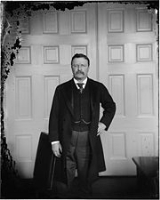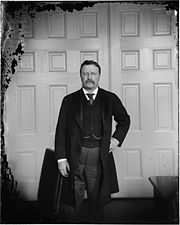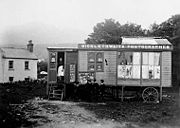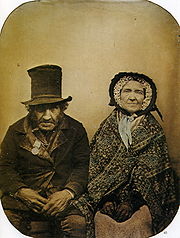
Collodion process
Encyclopedia

Photography
Photography is the art, science and practice of creating durable images by recording light or other electromagnetic radiation, either electronically by means of an image sensor or chemically by means of a light-sensitive material such as photographic film...
process. It was introduced in the 1850s and by the end of that decade it had almost entirely replaced the first practical photographic process, the daguerreotype
Daguerreotype
The daguerreotype was the first commercially successful photographic process. The image is a direct positive made in the camera on a silvered copper plate....
. During the 1880s the collodion process, in turn, was largely replaced by gelatin dry plates—glass plates with a photographic emulsion
Photographic emulsion
Photographic emulsion is a light-sensitive colloid, such as gelatin, coated onto a substrate. In silver-gelatin photography, the emulsion consists of silver halide crystals suspended in gelatin, and the substrate may be glass, plastic film, paper or fabric....
of silver halides suspended in gelatin. The dry gelatin emulsion was not only more convenient but could be made much more sensitive, greatly reducing exposure times.
"Collodion process" is usually taken to be synonymous with the "collodion wet plate process", a very inconvenient form which required the photographic material to be coated, sensitized, exposed and developed within the span of about fifteen minutes, necessitating a portable darkroom
Darkroom
A darkroom is a room that can be made completely dark to allow the processing of light sensitive photographic materials, including photographic film and photographic paper. Darkrooms have been created and used since the inception of photography in the early 19th century...
for use in the field. Although collodion was normally used in this wet form, the material could also be used in moist ("preserved") or dry form, but at the cost of greatly increased exposure time, making these forms unsuitable for the usual work of most professional photographers—portraiture. Their use was therefore confined to landscape photography and other special applications where minutes-long exposure times were tolerable.
Collodion processes were capable of recording microscopically fine detail, so their use for some special purposes continued long after the advent of the gelatin dry plate. The wet plate collodion process was still in use in the printing industry in the 1960s for line and tone work (mostly printed material involving black type against a white background) as for large work it was much cheaper than gelatin film. One collodion process, the tintype
Tintype
Tintype, also melainotype and ferrotype, is a photograph made by creating a direct positive on a sheet of iron metal that is blackened by painting, lacquering or enamelling and is used as a support for a collodion photographic emulsion....
, was still in limited use for casual portraiture by some itinerant and amusement park photographers as late as the 1930s, by which time tintypes were already regarded as quaintly old-fashioned.
The collodion process is said to have been invented, almost simultaneously, by Frederick Scott Archer
Frederick Scott Archer
Frederick Scott Archer invented the photographic collodion process which preceded the modern gelatin emulsion. He was born in Bishop's Stortford in the UK and is remembered mainly for this single achievement which greatly increased the accessibility of photography for the general public.tyler was...
and Gustave Le Gray
Gustave Le Gray
Jean-Baptiste Gustave Le Gray has been called "the most important French photographer of the nineteenth century" because of his technical innovations in the still new medium of photography, his role as the teacher of other noted photographers, and the extraordinary imagination he brought to picture...
in about 1850. During the subsequent decades of its popularity, many photographers and experimenters refined or varied the process.
Origin of the Process
In 1851, Frederick Scott ArcherFrederick Scott Archer
Frederick Scott Archer invented the photographic collodion process which preceded the modern gelatin emulsion. He was born in Bishop's Stortford in the UK and is remembered mainly for this single achievement which greatly increased the accessibility of photography for the general public.tyler was...
introduced a wet plate process, sometimes referred to as the collodion
Collodion
Collodion is a flammable, syrupy solution of pyroxylin in ether and alcohol. There are two basic types; flexible and non-flexible. The flexible type is often used as a surgical dressing or to hold dressings in place. When painted on the skin, collodion dries to form a flexible cellulose film...
process after the carrier material used. The process is simple: a bromide, iodide, or chloride is dissolved in collodion
Collodion
Collodion is a flammable, syrupy solution of pyroxylin in ether and alcohol. There are two basic types; flexible and non-flexible. The flexible type is often used as a surgical dressing or to hold dressings in place. When painted on the skin, collodion dries to form a flexible cellulose film...
(a solution of pyroxylin in alcohol and ether). This mixture is poured on a cleaned glass plate, which is allowed to sit until the coating gels but is still moist. The plate is then placed in a silver nitrate solution, which converts the iodide, bromide, or chloride to silver iodide, bromide or chloride. Once the reaction is complete, the plate is removed from the silver nitrate solution and exposed in a camera while still wet. The plate loses sensitivity as it dries, requiring it to be coated and sensitized immediately before use. It must also be developed while still moist, using a solution of iron sulfate, acetic acid and alcohol in water.
The sensitivity of silver halide
Silver halide
A silver halide is one of the compounds formed between silver and one of the halogens — silver bromide , chloride , iodide , and three forms of silver fluorides. As a group, they are often referred to as the silver halides, and are often given the pseudo-chemical notation AgX...
s to light is the underlying principle behind most types of 19th century photographic processes - Daguerreotype
Daguerreotype
The daguerreotype was the first commercially successful photographic process. The image is a direct positive made in the camera on a silvered copper plate....
s, Ambrotype
Ambrotype
right|thumb|Many ambrotypes were made by unknown photographers, such as this American example of a small girl holding a flower, circa 1860. Because of their fragility ambrotypes were held in folding cases much like those used for [[daguerreotype]]s...
s, Calotype
Calotype
Calotype or talbotype is an early photographic process introduced in 1841 by William Henry Fox Talbot, using paper coated with silver iodide. The term calotype comes from the Greek for 'beautiful', and for 'impression'....
s that use paper negatives, and wet and dry plate
Dry plate
Dry plate, also known as gelatin process, is an improved type of photographic plate. It was invented by Dr. Richard L. Maddox in 1871, and by 1879 it was so well introduced that the first dry plate factory had been established...
processes.
Advantages of wet plate

Daguerreotype
The daguerreotype was the first commercially successful photographic process. The image is a direct positive made in the camera on a silvered copper plate....
, produced a one-of-a-kind positive image, which could not be replicated easily. With the collodion process, however, the photographer could make an unlimited number of prints from a single negative; this was typically done on albumen paper
Albumen print
The albumen print, also called albumen silver print, was invented in 1850 by Louis Désiré Blanquart-Evrard, and was the first commercially exploitable method of producing a photographic print on a paper base from a negative...
.
Fox Talbot's Calotype process was a paper negative-positive process that preceded Collodion by about 11 years.
In addition to the convenience of creating negatives, the collodion process had numerous other advantages. It was an inexpensive process, especially in comparison with the daguerreotype. The polishing equipment and fuming equipment needed for the daguerreotype could be dispensed with entirely. The support for the images was glass, which was far less expensive than silver-plated copper, and was more consistent than paper for paper negatives. It was also fast for the time, requiring only seconds for exposure.
Disadvantages of Wet Plate
The wet collodion process had a major disadvantage. The entire process, from coating to developing, had to be done before the plate dried. This gave the photographer no more than 10 minutes to complete everything. This made it inconvenient for field use, as it required a portable darkroom. The plate dripped silver nitrate solution, causing stains and troublesome build-ups in the camera and plate holders.The silver nitrate bath was also a source of problems. It gradually became saturated with alcohol, ether, iodide and bromide salts, dust, and various organic matter. It would lose effectiveness, causing plates to mysteriously fail to produce an image.
As with all preceding photographic processes, the wet-collodion process was sensitive only to blue light. Warm colours appear dark, cool colours uniformly light. A sky with clouds is impossible to render, as the spectrum of white clouds contains about as much blue as the sky. Lemons and tomatoes appear a shiny black, and a blue and white tablecloth appears plain white. Victorian sitters who in collodion photographs look as if they are in mourning might have been wearing bright yellow or pink.
The collodion process becomes widely adopted

It is, in fact, still used by a number of artists and experimenters, who prefer its aesthetic qualities to those of the more modern gelatin silver process.
The Dry Collodion Process
The extreme inconvenience of shooting wet collodion in the field led to many attempts to develop a dry collodion process, which could be shot and developed some time after coating. A large number of methods were tried, though none were ever found to be truly practical and consistent in operation. Even well-known scientists such as Joseph Sidebotham, Richard Kennett, Major Russell and Frederick Charles Luther Wratten attempted, but never met with good results.Typically, these methods involved coating or mixing the collodion with a substance that prevented it from drying quickly. As long as the collodion remained at least partially wet, it retained some of its sensitivity. Common processes involved chemicals such as glycerin, magnesium nitrate
Magnesium nitrate
Magnesium nitrate is a hygroscopic salt with the formula Mg2. In air, it quickly forms the hexahydrate with the formula Mg2·6H2O . It is very soluble in both water and ethanol.-Uses:...
, tannic acid
Tannic acid
Tannic acid is a specific commercial form of tannin, a type of polyphenol. Its weak acidity is due to the numerous phenol groups in the structure...
and albumen. Others involved more unlikely substances, such as tea, coffee, honey, beer and seemingly unending combinations thereof.
Many of these worked to an extent; they allowed the plate to be exposed hours, or even days, after coating. They all possessed one chief disadvantage, however: regardless of the process used, they rendered the plate extremely slow. An image could require anywhere from three to ten times more exposure on a dry plate than on a wet plate.
Collodion Emulsion
In 1864 W. B. Bolton and B. J. Sayce published an idea for a process that would revolutionize photography. They suggested that sensitive silver salts be formed in a liquid collodion, rather than being precipitated, in-situ, on the surface of a plate. A light-sensitive plate could then be prepared by simply flowing this emulsion across the surface of a glass plate; no silver nitrate bath was required.This idea was soon brought to fruition. First, a printing emulsion was developed using silver chloride. These emulsions were slow, and could not be developed, so they were mostly used for positive printing. Shortly later, silver iodide and silver bromide emulsions were produced. These proved to be significantly faster, and the image could be brought out by development.
The emulsions also had the advantage that they could be washed. In the wet collodion process, silver nitrate reacted with a halide salt; potassium iodide, for example. This resulted in a double replacement reaction. The silver and iodine ions in solution reacted, forming silver iodide on the collodion film. However, at the same time, potassium nitrate also formed, from the potassium ions in the iodide and the nitrate ions in the silver. This salt could not be removed in the wet process. However, with the emulsion process, it could be washed out after creation of the emulsion.
The speed of the emulsion process was unremarkable. It was not as fast as the ordinary wet process, but was not nearly as slow as the dry plate processes. Its chief advantage was that each plate behaved the same way. Inconsistencies in the ordinary process were rare.
Collodion Emulsion Preparation Example
Below is an example of the preparation of a collodion emulsion, from the late 19th century. The language has been adapted to be more modern, and the units of measure have been converted to metric.4.9 grams of pyroxylin are dissolved in 81.3 ml of alcohol
Alcohol
In chemistry, an alcohol is an organic compound in which the hydroxy functional group is bound to a carbon atom. In particular, this carbon center should be saturated, having single bonds to three other atoms....
, 148 ml of ether
Ether
Ethers are a class of organic compounds that contain an ether group — an oxygen atom connected to two alkyl or aryl groups — of general formula R–O–R'. A typical example is the solvent and anesthetic diethyl ether, commonly referred to simply as "ether"...
.
13 grams of zinc bromide
Zinc bromide
Zinc bromide is a inorganic compound with the chemical formula ZnBr2. It is a colourless salt that shares many properties with zinc chloride , namely a high solubility in water forming acidic solutions, and solubility in organic solvents...
are dissolved in 29.6 ml of alcohol
Alcohol
In chemistry, an alcohol is an organic compound in which the hydroxy functional group is bound to a carbon atom. In particular, this carbon center should be saturated, having single bonds to three other atoms....
. Four or five drops of nitric acid
Nitric acid
Nitric acid , also known as aqua fortis and spirit of nitre, is a highly corrosive and toxic strong acid.Colorless when pure, older samples tend to acquire a yellow cast due to the accumulation of oxides of nitrogen. If the solution contains more than 86% nitric acid, it is referred to as fuming...
are added. This is added to half the collodion made above.
21.4 grams of silver nitrate
Silver nitrate
Silver nitrate is an inorganic compound with chemical formula . This compound is a versatile precursor to many other silver compounds, such as those used in photography. It is far less sensitive to light than the halides...
are dissolved in 7.4 ml of water. 29.6 ml of alcohol
Alcohol
In chemistry, an alcohol is an organic compound in which the hydroxy functional group is bound to a carbon atom. In particular, this carbon center should be saturated, having single bonds to three other atoms....
are added. This is then poured into the other half of the collodion; the brominized
Bromine
Bromine ") is a chemical element with the symbol Br, an atomic number of 35, and an atomic mass of 79.904. It is in the halogen element group. The element was isolated independently by two chemists, Carl Jacob Löwig and Antoine Jerome Balard, in 1825–1826...
collodion dropped in, slowly, while stirring.
The result is an emulsion of silver bromide
Silver bromide
Silver bromide , a soft, pale-yellow, water insoluble salt well known for its unusual sensitivity to light. This property has allowed silver halides to become the basis of modern photographic materials. AgBr is widely used in photographic films and is believed by some to have been used for making...
. It is left to ripen for 10 to 20 hours, until it attains a creamy consistency. It may then be used or washed, as outlined below.
To wash, the emulsion is poured into a dish and the solvents are evaporated, until the collodion becomes gelatinous. It is then washed with water, followed by a washing in alcohol. After washing, it is re-dissolved in a mixture of ether and alcohol, and is ready for use.
Emulsions created in this manner could be used wet, but they were often coated on the plate and preserved in similar ways to the dry process.
Collodion emulsion plates were developed in an alkaline developer, not unlike those in common use today. An example formula follows.
Part A:
Pyrogallic acid 96 g
Alcohol 1 oz.
Part B:
Potassium bromide
Potassium bromide
Potassium bromide is a salt, widely used as an anticonvulsant and a sedative in the late 19th and early 20th centuries, with over-the-counter use extending to 1975 in the United States. Its action is due to the bromide ion...
12 g
Distilled Water 30 ml
Part C:
Ammonium carbonate
Ammonium carbonate
Ammonium carbonate is a commercial salt with the chemical formula 2CO3. It is used when crushed as a smelling salt. It can be crushed when needed in order to revive someone who has fainted...
80 g
Water 30 ml
When needed for use, mix 0.37 ml of A, 2.72 ml of B and 10.9 ml of C. Flow this over the plate until developed. If a dry plate is used, first wash the preservative off in running water.
Chemical Reactions Involved in the Process
Reactions involved in the collodion processes are the same as those that apply other photographic processes. The iodide, chloride or bromide salts in the collodion react with silver nitrateSilver nitrate
Silver nitrate is an inorganic compound with chemical formula . This compound is a versatile precursor to many other silver compounds, such as those used in photography. It is far less sensitive to light than the halides...
to produce silver iodide
Silver iodide
Silver iodide is a yellow, inorganic, photosensitive iodide of silver used in photography, in medicine as an antiseptic, and in rainmaking for cloud seeding.-Crystal structure:...
, silver chloride
Silver chloride
Silver chloride is a chemical compound with the chemical formula AgCl. This white crystalline solid is well known for its low solubility in water . Upon illumination or heating, silver chloride converts to silver , which is signalled by greyish or purplish coloration to some samples...
or silver bromide
Silver bromide
Silver bromide , a soft, pale-yellow, water insoluble salt well known for its unusual sensitivity to light. This property has allowed silver halides to become the basis of modern photographic materials. AgBr is widely used in photographic films and is believed by some to have been used for making...
. These are unstable to light, and are chemically changed upon exposure. They are reduced to metallic silver by the developer.
Wet plate today
The wet plate collodion process has undergone a revival as a historical technique over the past few decades. There are several practicing ambrotypists and tintypists who regularly set up and do images at Civil War re-enactments. Many fine art photographers also use the process and its handcrafted individuality for gallery showings and personal work. There are several makers of reproduction equipment for the contemporary practitioner. The process is taught in workshops around the world and several workbooks and manuals are currently in print.There are many artists working with Collodion for several different reasons,including American artist, Sally Mann
Sally Mann
Sally Mann is an American photographer, best known for her large black-and-white photographs—at first of her young children, then later of landscapes suggesting decay and death.-Early life and education:...
and New York based artist Jill Enfield
Jill Enfield
Jill Enfield born 1954 in Miami Beach, Florida, is a photographer and hand coloring artist best known for her work in alternative photographic processes such as Cyanotype and Collodion process...
Mark Osterman and France Scully Osterman established Scully & Osterman in 1991 http://www.collodion.org
Quinn Jacobson was born in America in 1964 http://studioq.com
The pioneer artist in Asia is Ho Man Kei.
The pioneer artist in Ukraine Roman Kravchenko, leading
contemporary wetplate artist in Austria is Stefan Sappert.
External links
- The Getty Museum: The Wet Collodion Process
- Step by Step Wet Plate Photography
- Making a Photograph During the Brady Era
- Mathew Brady
- Charles Dodgson (aka Lewis Carroll) - Photographer
- William Henry Jackson
- Carleton Watkins
- Roger Fenton Crimean War Photographs
- Civil War Photographs from the National Archive
- Collodion: Material Safety Data Sheet
- Compound W data sheet
- World Wet Plate Day
- Getting Started In Wetplate Collodion Photography

